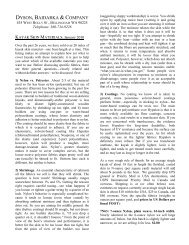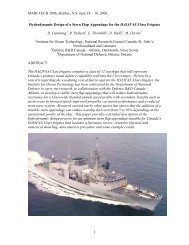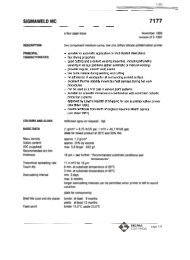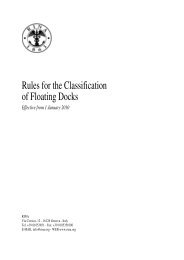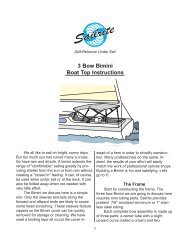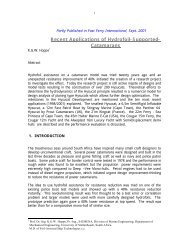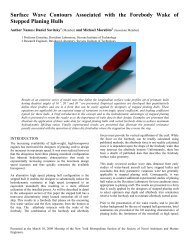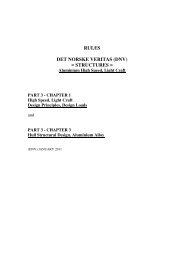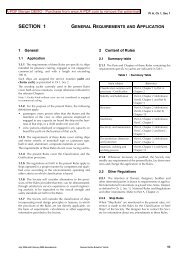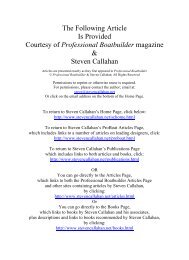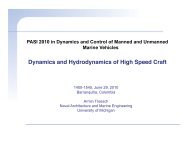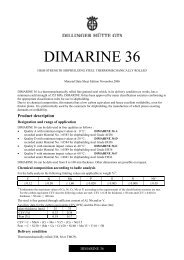Origin and Characteristics of the Spray Patterns TR-2882 3-10 ...
Origin and Characteristics of the Spray Patterns TR-2882 3-10 ...
Origin and Characteristics of the Spray Patterns TR-2882 3-10 ...
You also want an ePaper? Increase the reach of your titles
YUMPU automatically turns print PDFs into web optimized ePapers that Google loves.
<strong>TR</strong>-<strong>2882</strong><br />
<strong>and</strong> completely obscure <strong>the</strong> bow wave. For all speeds, <strong>the</strong> height <strong>of</strong> bow wave crest is relatively small. These<br />
characteristics are demonstrated by a series <strong>of</strong> photographs taken by Savitsky <strong>and</strong> Breslin (1958). These are reproduced<br />
<strong>and</strong> discussed in <strong>the</strong> test section <strong>of</strong> this report.<br />
While many <strong>of</strong> <strong>the</strong> notations in Fig. 2 are self explanatory, it is important to define <strong>the</strong> stagnation line <strong>and</strong> <strong>the</strong> spray<br />
root line. Specifically, <strong>the</strong> stagnation line is a locus <strong>of</strong> points on <strong>the</strong> bottom along which <strong>the</strong> flow is divided into<br />
forward <strong>and</strong> aft components <strong>and</strong> on which <strong>the</strong> pressure is a maximum <strong>and</strong> is developed from bringing to rest <strong>the</strong><br />
component <strong>of</strong> free stream velocity normal to this line. ( fur<strong>the</strong>r discussion is given in a subsequent section <strong>of</strong> this<br />
report). Just forward <strong>of</strong> <strong>the</strong> stagnation line is <strong>the</strong> so-called spray root line. This defines <strong>the</strong> forward extent <strong>of</strong> <strong>the</strong> wetted<br />
bottom area when planing. According to <strong>the</strong>oretical (Wagner, 1932) <strong>and</strong> experimental (typically Savitsky <strong>and</strong><br />
Neidinger, 1954) results, <strong>the</strong> actual wetted width at any cross section through <strong>the</strong> bottom is essentially π/2 times <strong>the</strong><br />
wetted width defined by <strong>the</strong> level water line intersection with <strong>the</strong> bottom. This is referred to as <strong>the</strong> “wave-rise’ factor.<br />
The angle <strong>of</strong> <strong>the</strong> spray root line, α, relative to <strong>the</strong> keel measured in a plane normal to <strong>the</strong> hull centerline <strong>and</strong> along <strong>the</strong><br />
keel can be established from a knowledge <strong>of</strong> <strong>the</strong> deadrise, trim <strong>and</strong> π/2 wave rise factor. Thus, it can be shown that:<br />
α =<br />
⎛ π tanτ<br />
⎞<br />
⎜ ⎟<br />
⎝ 2 tan β ⎠<br />
−1<br />
Tan Eq. 1<br />
Because <strong>the</strong> stagnation line <strong>and</strong> <strong>the</strong> spray root line are very close to each o<strong>the</strong>r, <strong>the</strong> π/2 wave rise factor is <strong>of</strong>ten applied<br />
to both lines.<br />
Also shown on Fig.2 is <strong>the</strong> forward extent <strong>of</strong> <strong>the</strong> whisker spray area. Subsequent sections <strong>of</strong> this paper compute <strong>the</strong><br />
angle between <strong>the</strong> keel <strong>and</strong> <strong>the</strong> forward boundary <strong>of</strong> this spray component. Savitsky, Delorme, <strong>and</strong> Datla, (2007)<br />
presented a method for estimating <strong>the</strong> viscous resistance <strong>of</strong> <strong>the</strong> fluid that traverses this hull bottom area before being<br />
projected from <strong>the</strong> chines to become <strong>the</strong> visible whisker spray.<br />
Fluid Flow Pattern along <strong>the</strong> Stagnation Line<br />
To provide an underst<strong>and</strong>ing <strong>of</strong> <strong>the</strong> flow directions along <strong>the</strong> bottom <strong>of</strong> a planing hull, short lengths <strong>of</strong> s<strong>of</strong>t fiber tufts<br />
were attached to <strong>the</strong> bottom <strong>of</strong> a prismatic deadrise hull. Fig.3 is an underwater photograph showing <strong>the</strong> alignment <strong>of</strong><br />
<strong>the</strong> tufts with <strong>the</strong> hull underway. It is immediately apparent that <strong>the</strong> tufts are aligned with <strong>the</strong> stagnation line, thus<br />
indicating a velocity component that is directed along this line from keel to chine. Of fur<strong>the</strong>r interest regarding this<br />
flow pattern are <strong>the</strong> results <strong>of</strong> bottom pressure measurements made by Smiley (1951). It was shown that, except at <strong>the</strong><br />
chine where <strong>the</strong> pressure must be atmospheric, <strong>the</strong> pressure distribution along <strong>the</strong> stagnation line is constant (see Fig.<br />
4). Thus, according to <strong>the</strong> Bernoulli equation, <strong>and</strong> excluding viscous effects, <strong>the</strong> velocity along this line is essential<br />
constant.<br />
This is an important observation that confirms assumptions by o<strong>the</strong>r researchers (i.e. Pierson & Leshnover, 1950) that<br />
<strong>the</strong> resultant three-dimensional flow pattern in <strong>the</strong> chines-dry region <strong>of</strong> planing hulls can be decomposed into two<br />
components; one along <strong>the</strong> line <strong>and</strong> <strong>the</strong> o<strong>the</strong>r normal to <strong>the</strong> stagnation line. This is analogous to <strong>the</strong> aerodynamic<br />
treatment <strong>of</strong> flows over swept-back wings, where <strong>the</strong> free stream velocity, V, is resolved into components normal to,<br />
Vn, <strong>and</strong> along <strong>the</strong> span, Vs, <strong>of</strong> <strong>the</strong> wing leading edge as shown in Fig.5a. For <strong>the</strong> case <strong>of</strong> a planing surface <strong>the</strong> free<br />
stream velocity can be resolved into components normal to (Vn), <strong>and</strong> along <strong>the</strong> stagnation line (Vs) as shown in Fig.5b.<br />
As will be demonstrated in <strong>the</strong> subsequent sections <strong>of</strong> this report, this representation forms <strong>the</strong> foundation for<br />
describing <strong>the</strong> common origin <strong>of</strong> both <strong>the</strong> whisker spray <strong>and</strong> <strong>the</strong> main spray.<br />
Using <strong>the</strong> equation for <strong>the</strong> angle α defined in Eq. 1:<br />
Vn = V sinα<br />
Eq. 2<br />
Vs = V cosα<br />
Eq. 3<br />
The <strong>Spray</strong> <strong>Patterns</strong> in Two-Dimensional Planes<br />
Since Vs is essentially constant along <strong>the</strong> stagnation line, it follows that <strong>the</strong> flow in planes normal to <strong>the</strong> stagnation line<br />
(Vn) may be treated as two-dimensional flows. Fig. 6 is sketch <strong>of</strong> <strong>the</strong> chines dry region <strong>of</strong> a planing hull. Considering<br />
planes normal to <strong>the</strong> stagnation line (sections k-c), it can be assumed that <strong>the</strong> fluid flow in <strong>the</strong>se sections is equivalent<br />
to <strong>the</strong> flow about an equivalent flat plate planing at an effective trim angle τ’ <strong>and</strong> a velocity Vn. If <strong>the</strong> plane k-c is taken<br />
fixed in space <strong>and</strong> <strong>the</strong> planing surface is made to pass through this plane at constant V, an examination <strong>of</strong> <strong>the</strong> changing<br />
3



